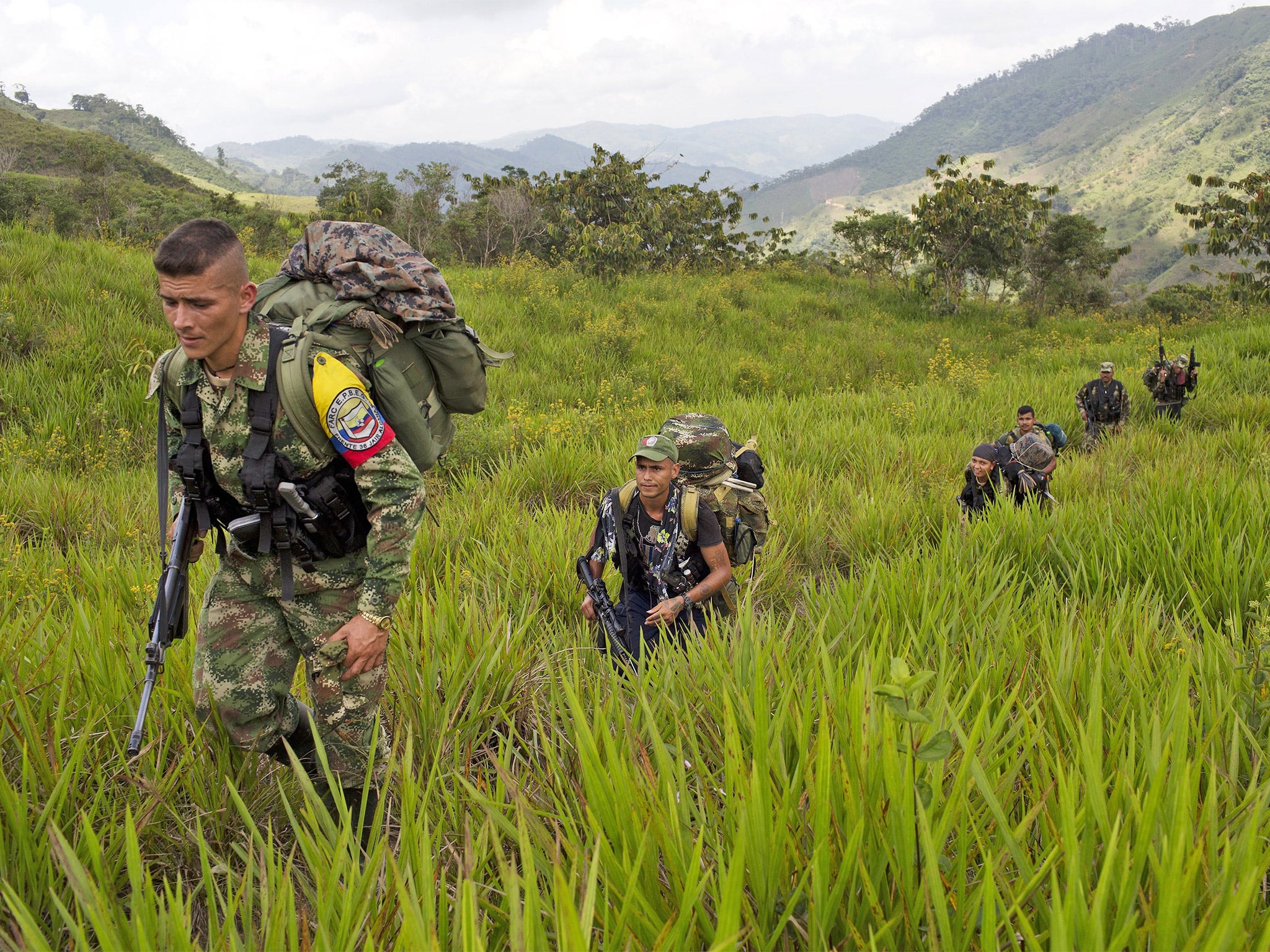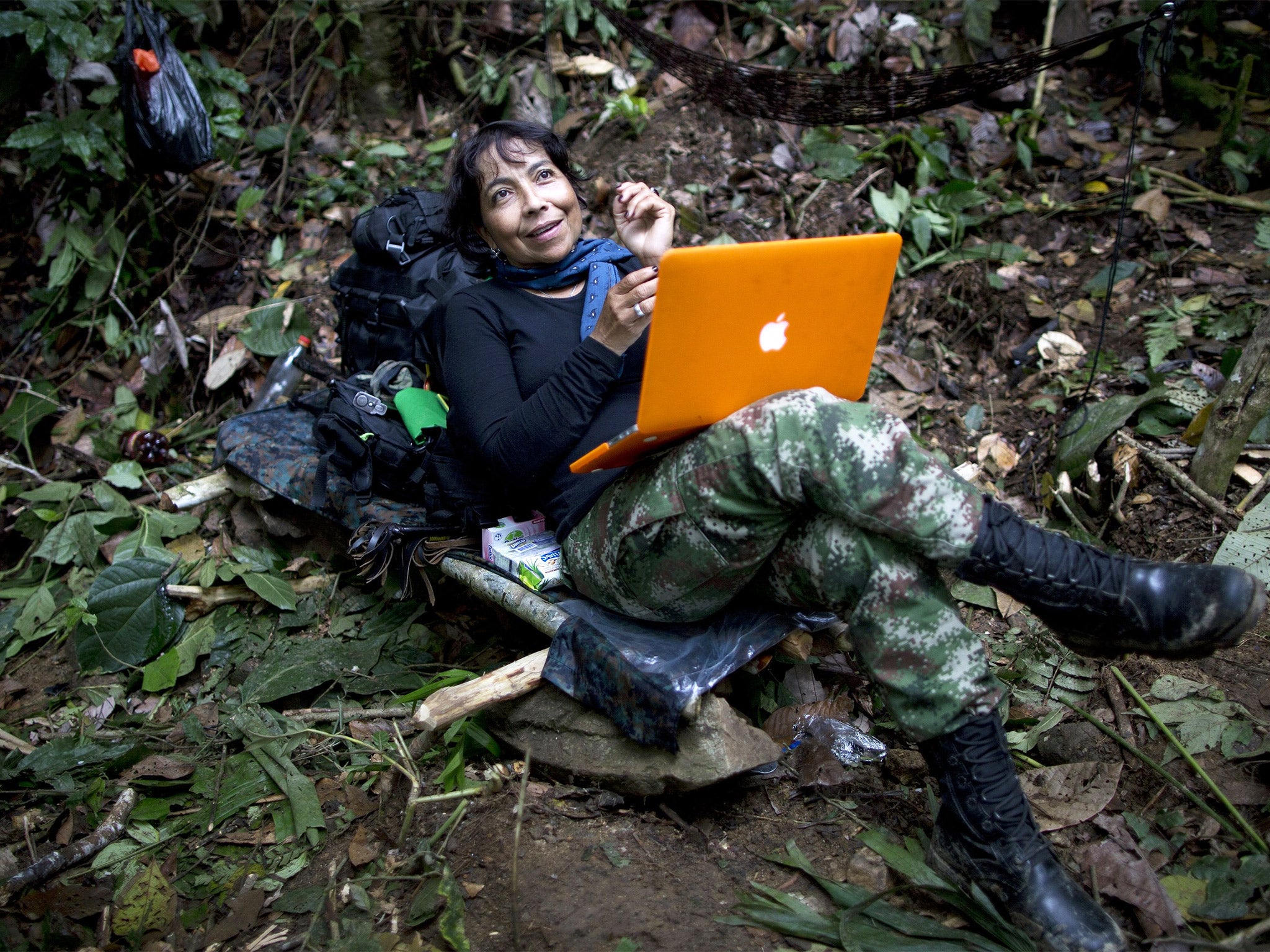Farc: Meet Colombia's rebel fighters preparing for peace after more than half-century of conflict with government
A deadline for an agreement between the guerrillas and the government has been set for 23 March, but the transition back to a normal life is filling the groups 7,000 fighters with a mixture of pride and trepidation

Your support helps us to tell the story
From reproductive rights to climate change to Big Tech, The Independent is on the ground when the story is developing. Whether it's investigating the financials of Elon Musk's pro-Trump PAC or producing our latest documentary, 'The A Word', which shines a light on the American women fighting for reproductive rights, we know how important it is to parse out the facts from the messaging.
At such a critical moment in US history, we need reporters on the ground. Your donation allows us to keep sending journalists to speak to both sides of the story.
The Independent is trusted by Americans across the entire political spectrum. And unlike many other quality news outlets, we choose not to lock Americans out of our reporting and analysis with paywalls. We believe quality journalism should be available to everyone, paid for by those who can afford it.
Your support makes all the difference.The rebel leader known as Juan Pablo carries with him a new telescopic assault rifle and a heavy heart.
As a commander of the 36th Front of the Revolutionary Armed Forces of Colombia (Farc), one of the most active units in a half-century of bloodshed, the paunch-bellied warrior has spent 25 years plotting ambushes and assembling land mines but has never been to the cinema, driven a car or eaten in a restaurant.
Now peace appears within reach as a self-imposed deadline of 23 March for an agreement between the guerrillas and the government approaches. So, for the first time Juan Pablo, 41, is thinking about a future outside this jungle hideout. His dream: to return to the poor village he left as a teenager and run for mayor. But transition to civilian life will come without his girlfriend and comrade-in-arms who was killed six months ago in an army raid, underscoring the toll still being exacted by Latin America’s last major guerrilla conflict even as it winds down.
“This war is going to end without victors… but lots of suffering on both sides,” said Juan Pablo, the son of a street vendor. “It’s false to say we arrived defeated to the negotiating table. They dealt us some heavy blows, of course, but 51 years of war against an enemy backed by the most powerful army in the world [the US army] has not made us cower.”
That mixture of pride and trepidation about the future is common among Farc’s roughly 7,000 fighters, many of whom, like Juan Pablo, come from poor rural beginnings and struggle to imagine life outside the highly regimented ranks of the guerrillas.
Decades of fighting between guerrillas, right-wing paramilitaries and the armed forces has, according to government figures, left a toll of more than 220,000 dead, some 40,000 missing and more than five million driven from their homes.
But after President Juan Manuel Santos travelled to Cuba in September and shook the hand of Farc’s top commander, both sides feel confident enough to predict a final deal. On Monday, the UN Security Council unanimously approved a resolution to establish a political mission to monitor and verify a future ceasefire, after the government and Farc made a joint request to the UN that such a body be set-up.
The resolution approved by the 15-member council said the UN would establish a political mission for 12 months “to monitor and verify the definitive bilateral ceasefire and cessation of hostilities, and the laying down of arms”.
If peace deal arrives, this generation of Farc guerrillas would be the first to fight for their ideals at the ballot box.
During a recent visit to a Farc camp in Antioquia state, the day starts at around 4.30am The jungle comes to life to the sound of metal pots clanging as breakfast is prepared. Farc insisted that the location of the camp, said to be home to 22 rank-and-file fighters, four commanders and two dogs, not be revealed to protect the lives of its fighters.

Thanks to a unilateral Farc ceasefire, it has been months since gunshots rang out in this remote corner of the Andes. Still, the rebels show no sign of letting down their guard.
They sleep with their weapons, restrict all conversation at night and use assumed names. Once-a-day radio contact with other units happens via code, and lengthier missives are saved to thumb drives and transported through a network of human couriers.
Their wariness highlights one of the thorniest issues that negotiators must still work out: how and under whose auspices Farc will demobilise, when experience has taught the rebels that politics can be just as perilous as war.
The guerrillas recall too well how during 1980s peace talks that ultimately failed, Farc established a party known as the Patriotic Union as its political arm.
In just a few years, more than 3,000 leftist activists, rebel sympathisers and two presidential candidates were gunned down by paramilitaries. It became a cautionary tale in a country plagued by political violence.
“We learnt a lot from that experience, but who says the only way to practise politics is in Congress?” said Leonidas, another commander. “One thing is clear: in this new phase Farc is not going to demobilise, we are going to mobilise [politically]”.
The rebels tried to downplay Farc’s deep involvement in drugs – a lucrative trade that could prove a powerful economic incentive to remain armed. Families living in the remote valleys that the 36th Front lords over acknowledge paying a war tax to protect their coca plantings, but the rebels say they will help develop alternative crops if an accord is reached.
Even as the camp maintains a wartime footing, the guerrillas have begun holding twice-a-day peace assemblies. On a recent day the first one, before breakfast, was led by Yira Castro, a commander. Under the shade of a tree, she read from a 63-page sub-accord that was recently signed during peace talks in Havana.

Listening attentively was Juliana. Like many others, her path to Farc was born as much from personal tragedy as political ideology. At age 16, after she says she was raped by her stepfather, she fled her impoverished home.
Juliana said that if she hadn’t taken up arms she would have liked to have studied computers. But now she hopes to serve Farc even during peacetime: “I want to prepare myself to get involved in politics and continue my association with the organisation.”
Talk came to an abrupt halt as an unfamiliar aircraft flew overhead a second time, setting nerves on edge. “Politics is a lot tougher than war,” another commander, Anibal, observed from his hammock.
“You pay for a mistake on the battlefield with your life,” he said, swinging back and forth, “but an error in the field of politics brings down an entire organisation.”
AP
Join our commenting forum
Join thought-provoking conversations, follow other Independent readers and see their replies
Comments